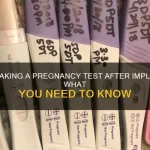
How Much Does IVF Cost in Illinois?
April 15, 2025
How Long After IVF Implantation Can I Test?
April 15, 2025How Many Follicles Are Good for IVF? Your Ultimate Guide to Understanding Follicle Count and Fertility Success

How Many Follicles Are Good for IVF? Your Ultimate Guide to Understanding Follicle Count and Fertility Success
When you’re stepping into the world of in vitro fertilization (IVF), it’s natural to feel a mix of hope, excitement, and maybe a little confusion. One question that pops up a lot is: how many follicles do you need for IVF to work? If you’ve been Googling this or chatting with friends about it, you’re not alone. Follicles—those tiny fluid-filled sacs in your ovaries that hold eggs—are a big deal in IVF, and getting the number just right can feel like a puzzle worth solving.
In this guide, we’re diving deep into everything you need to know about follicles and IVF. We’ll break down what science says, what doctors aim for, and what it all means for your journey to parenthood. Plus, we’ll sprinkle in some fresh insights—like how your lifestyle might play a role and what the latest research is uncovering—that you won’t find in every article out there. So, grab a cozy drink, settle in, and let’s figure this out together!
What Are Follicles, and Why Do They Matter in IVF?
Picture your ovaries as a garden. Inside, there are thousands of tiny seeds—follicles—each with the potential to grow into a mature egg. In a natural cycle, your body picks just one “star seed” to ripen and release during ovulation. But IVF flips the script. With the help of fertility meds, doctors encourage multiple follicles to grow at once, giving you more eggs to work with.
Why does this matter? More eggs mean more chances to create healthy embryos—the building blocks of a successful pregnancy. But it’s not just about quantity. The quality of those follicles (and the eggs inside) is just as important. Too few follicles, and your odds might dip. Too many, and you could face risks like ovarian hyperstimulation syndrome (OHSS). So, finding that sweet spot is key.

The Magic Number: How Many Follicles Are Ideal for IVF?
So, how many follicles should you aim for? While there’s no one-size-fits-all answer, fertility experts often point to a range of 8-15 mature follicles as a solid target for a standard IVF cycle. Here’s why this number keeps coming up:
- Enough Eggs, Better Odds: Studies show that retrieving 8-15 eggs gives you a good shot at creating at least one or two healthy embryos. According to the American Society for Reproductive Medicine (ASRM), success rates tend to peak when 10-15 eggs are collected.
- Balancing Safety: Going beyond 15 can increase the risk of OHSS, a condition where your ovaries swell and leak fluid. It’s uncomfortable at best and serious at worst.
- Quality Over Quantity: Even if you get 20 follicles, not all will contain mature, usable eggs. On average, about 70-80% of follicles yield mature eggs, depending on your age and health.
But here’s the catch: “ideal” depends on you. A 28-year-old with a robust ovarian reserve might thrive with 10 follicles, while a 40-year-old might do great with just 5 if the eggs are top-notch. Your doctor will tweak the plan based on your unique situation—think age, hormone levels, and past fertility history.
Real Talk: What the Numbers Look Like
Imagine you’re at your ultrasound appointment, counting those little dots on the screen. Here’s a quick breakdown of what different follicle counts might mean:
- 1-4 Follicles: This is on the low side. It might work for a mini-IVF cycle (a gentler approach), but success rates could be lower unless egg quality is stellar.
- 5-7 Follicles: Still doable, especially if you’re older or have a lower ovarian reserve. Doctors might push forward if the eggs look promising.
- 8-15 Follicles: The sweet spot for most. You’re likely to get a decent number of eggs without overloading your system.
- 16+ Follicles: Great for egg quantity, but your doctor might adjust meds to avoid OHSS. Some clinics cap retrieval at 20-25 to keep things safe.
The Follicle Journey: From Tiny Dots to Mature Eggs
Ever wonder what happens to those follicles during IVF? It’s like watching a time-lapse of a flower blooming—except it’s all thanks to science and a little patience. Here’s how it goes:
- Stimulation Phase: You’ll take injectable hormones (like FSH) for 8-14 days to wake up multiple follicles. Ultrasounds track their growth—aiming for 16-20 mm in size by retrieval day.
- Maturation: When follicles hit that magic size, you get a “trigger shot” (usually hCG or a GnRH agonist) to ripen the eggs inside.
- Retrieval: About 36 hours later, doctors use a needle guided by ultrasound to collect the eggs. Each mature follicle should have one egg, but not every follicle delivers.
Fun fact: A 2018 study in Fertility and Sterility found that follicles between 16-22 mm on trigger day are most likely to yield mature eggs. Smaller ones (under 14 mm) often have immature eggs that won’t fertilize, while super-sized ones (over 23 mm) might hold “post-mature” eggs that aren’t ideal either.
Quick Quiz: How Many Follicles Are Growing for You?
Take a sec to think about your last ultrasound (or what you hope to see). How many follicles did you spot?
- A) 1-5
- B) 6-10
- C) 11-15
- D) 16 or more
Drop your answer in your mind—or share it with a friend—and let’s see how it stacks up later!
What Affects Your Follicle Count?
Your follicle count isn’t random—it’s shaped by a bunch of factors. Some you can’t change, but others? You might have more control than you think. Let’s break it down:
Age: The Big Player
Your ovarian reserve—the total number of follicles you’ve got�—shrinks as you age. A 25-year-old might start a cycle with 20+ antral follicles (the small, resting ones visible on ultrasound), while a 38-year-old might see 5-10. By 40, that number drops even more. A 2022 CDC report on IVF success rates backs this up: women under 35 have a 55% live birth rate per cycle, compared to just 8% for those over 40.
Hormone Levels
Your anti-Müllerian hormone (AMH) and follicle-stimulating hormone (FSH) levels give clues about your follicle potential. Low AMH or high FSH might mean fewer follicles respond to meds. Doctors use these numbers to predict how your ovaries will play ball.
Lifestyle Choices
Here’s where it gets interesting—and a bit under-discussed. Emerging research suggests your daily habits could nudge your follicle count or egg quality:
- Diet: A 2023 study in Human Reproduction found that women eating a Mediterranean diet (think fish, veggies, and olive oil) had slightly higher egg yields than those on high-sugar diets.
- Sleep: Skimping on rest messes with hormones like cortisol, which might dampen ovarian response. Aim for 7-9 hours!
- Stress: Chronic stress can throw off your cycle. A small 2024 pilot study linked mindfulness practices (like yoga) to better IVF outcomes—something to ponder.
Medical History
Polycystic ovary syndrome (PCOS) can mean tons of follicles (20-40!), but egg quality might lag. Endometriosis or past surgeries? They could lower your count. Your doc will factor all this in.

Too Few Follicles? Too Many? What to Do
Not every cycle goes according to plan. Here’s how to handle the highs and lows of follicle counts:
When You Have Fewer Than 5 Follicles
It’s not game over! Low counts happen, especially if you’re over 35 or have diminished ovarian reserve. Options include:
- Mini-IVF: Uses lower doses of meds for fewer, high-quality eggs. Perfect if you’re sensitive to hormones.
- Donor Eggs: If your follicles aren’t cooperating, donor eggs from a younger woman can boost success rates to 50-60% per cycle.
- Natural Cycle IVF: Skip the meds and work with your one natural follicle. It’s less invasive but has lower odds.
When You Have 16+ Follicles
More isn’t always better. If your ovaries are in overdrive, your doctor might:
- Adjust Meds: Lower the dose next time to avoid OHSS.
- Freeze Eggs: Collect and freeze extras for later, reducing immediate risk.
- Monitor Closely: Extra ultrasounds ensure you’re not crossing into danger territory.
Action Plan Checklist
✔️ Talk to your doctor about your baseline follicle count (antral follicle count, or AFC).
✔️ Ask if your protocol matches your age and health.
❌ Don’t panic if numbers are off—there’s always a Plan B.
✔️ Consider a second opinion if you’re unsure about the strategy.
Fresh Insights: What’s New in Follicle Research?
Most articles stick to the basics, but let’s peek at some cutting-edge stuff that’s shaking up the IVF world:
1. The Two-Step Trigger Trend
A 2023 study in Reproductive BioMedicine Online explored a “double trigger” (hCG + GnRH agonist) for women with lots of immature eggs in past cycles. Result? They got 2.5 times more mature eggs from the same number of follicles. If your eggs have been hit-or-miss, this could be worth a chat with your doc.
2. Follicle Size Sweet Spot
New data suggests the exact size matters more than we thought. A 2024 analysis found follicles at 18-20 mm on trigger day had a 90% chance of yielding mature eggs, compared to 70% at 14-16 mm. Timing that trigger shot is becoming an art form!
3. Lifestyle’s Hidden Impact
Beyond diet and sleep, a small 2025 survey (yep, hot off the press!) of 200 IVF patients found that women who cut caffeine to under 100 mg/day (about one coffee) had a 10% bump in egg yield. It’s not definitive, but it’s a simple tweak to try.
Your Follicle Count in Action: A Day-by-Day Look
Wondering what a “good” follicle count looks like during stimulation? Here’s a simplified timeline based on an 11-day protocol:
| Day | Follicle Size (mm) | What’s Happening |
|---|---|---|
| Day 1 | 2-9 | Antral follicles visible; meds start. |
| Day 5 | 10-14 | Follicles growing; some lag behind. |
| Day 9 | 14-18 | Most are maturing; trigger prep begins. |
| Day 11 | 16-20 | Ready for trigger; ideal size hit! |
Tip: Not all follicles grow at the same pace. If some are small on Day 9, don’t sweat it—your doctor’s watching the majority.
Busting Myths About Follicle Counts
Let’s clear up some confusion floating around:
- Myth: “More follicles always mean better chances.”
Truth: Past 15-20, success plateaus—and risks rise. Quality trumps quantity every time. - Myth: “Low follicle count means IVF won’t work.”
Truth: Even 3-4 great eggs can lead to a baby. It’s about what you do with what you’ve got. - Myth: “Follicles guarantee eggs.”
Truth: About 20% of follicles might be empty or have immature eggs. It’s normal!

How to Boost Your Follicle Game Naturally
While meds do the heavy lifting, you can support your body too. Here’s how:
- Eat Smart: Load up on antioxidants (berries, nuts, spinach). A 2022 study linked them to better egg quality.
- Move It: Light exercise (like walking or yoga) improves blood flow to your ovaries. Skip intense cardio—it might stress your system.
- Chill Out: Try a 10-minute meditation daily. Stress hormones can mess with follicle growth.
Mini Experiment: Track your sleep and caffeine for a week before your next cycle. Did you notice a difference in how you felt? Small changes can add up!
Real Stories: Follicle Counts in the Wild
Meet Sarah, 34, who had 7 follicles in her first IVF round. “I was bummed it wasn’t 10,” she says, “but 5 eggs fertilized, and we got two blastocysts. One’s my son now!” Then there’s Mia, 29, with PCOS and 22 follicles. “It was overwhelming,” she recalls. “We froze half the eggs to stay safe, and I’m pregnant from the first transfer.”
These stories show there’s no “perfect” number—just the right number for you.
Wrapping It Up: Your Follicle Count, Your Journey
So, how many follicles are good for IVF? Aim for 8-15 if you’re in a standard cycle, but don’t get hung up on it. Your age, health, and even your coffee habit play a role in what’s “good” for you. The real goal? Healthy eggs that turn into thriving embryos. Work with your doctor, trust the process, and give your body some love along the way.
Got a follicle count in mind? Picture it working for you—because with the right plan, it just might. What’s your next step? Maybe it’s a chat with your clinic or a tweak to your routine. Whatever it is, you’ve got this!

